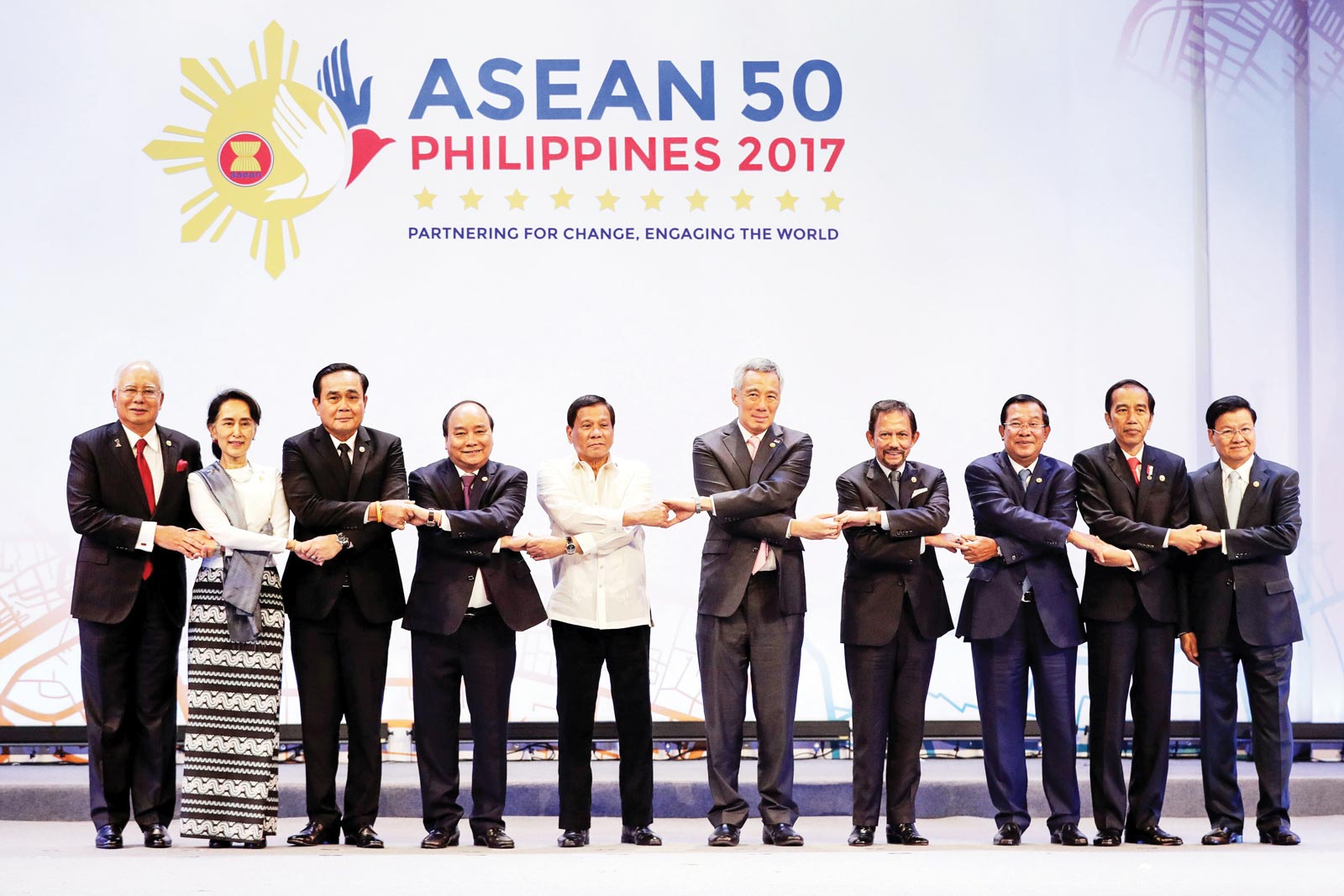The Association of Southeast Asian Nations (Asean) will turn 50 on 8 August – an anniversary that is sure to be celebrated with more style than substance. Yes, the group has achieved a lot since 1967, but one cannot help but feel it’s presently in the grip of a midlife crisis – seeking, but failing, to find a new sense of purpose and identity. Asean leaders need to break from tradition and find the courage to make difficult decisions if the group is to flourish over the next 50 years.
Most, if not all, of Asean’s most prominent backers point to continued peace between the ten member states as one of the bloc’s biggest achievements since its founding – and rightly so. The group has also succeeded in putting major powers in the same room, even in difficult times, through forums such as the annual Asean and East Asia Summits. Some will even flag up Myanmar’s turn to democracy as a uniquely Asean achievement.
Regional economic links have also deepened, thanks in large part to the Asean Trade in Goods Agreement. Last year, intra-Asean flows of foreign direct investment accounted for 25% of what the region received in total, up from 15% in 2010. The proportion of intra-Asean trade in goods to the bloc’s total shipments also stands at around the same level, while more than 40% of tourist arrivals come from within the region.
Trade and investment ties are only likely to mature in the years ahead, with Asean projected to remain one of the fastest-growing economic blocs in the world. Indeed, the Economist Intelligence Unit expects the region as a whole to grow at an annual average rate of about 4.5% over the coming years – an impressive rate in the context of a global economy that will struggle to muster 2% per annum.
A few Asean-led initiatives will help in this regard. In particular, the progress of the Asean Single Window is one to watch. Its full implementation would greatly ease intra-regional trade as the integration of each member states’ National Single Windows speeds up customs clearance. In addition, the bloc’s Banking Integration Framework is also gaining momentum. The initiative opens the doors for “Qualified Asean Banks” to operate in other member states without much discrimination.
The territorial disputes between a number of member states and China in the South China Sea could be more quickly resolved, and to the greater benefit of claimants in Asean, if there was less bickering within the group about communiqués.
So where’s the midlife crisis?
The answer partly lies in the half-baked formation of the Asean Community in 2015. This much-vaunted establishment – which would encompass the three blueprints of economic (AEC), political-security (APSC) and socio-cultural (ASCC) cooperation – at the end of that year took place without any real change. For the most part, the group’s response has been to kick the can down the road – to 2025 – putting a stamp on new(ish) “blueprints” for said community building.
The midlife crisis also stems from Asean’s inability, and dare I say occasional unwillingness, to respond in a unified way to challenges both old and new. The territorial disputes between a number of member states and China in the South China Sea could be more quickly resolved, and to the greater benefit of claimants in Asean, if there was less bickering within the group about communiqués. There are some structures in place to mitigate the yearly transboundary haze that engulfs large swaths of the region, but enforcement remains weak.
Not surprisingly, Asean has taken a hands-off approach to a host of festering domestic issues that have regional consequences: including the persecution of the Rohingya in Myanmar and the deteriorating security situation in the southern Philippines (to name just two). Crucially, there is still little recognition that peace is not simply the absence of war. The bloc is thriving economically, which is a double-edged sword because such performance has bred complacency. Nothing of substance has been proposed at a regional level to respond to a slowing China and inevitable labour displacement through automation.
The longer Asean dithers on its grand ambitions and these regional challenges, the greater the risk that it starts to lose whatever faith has been placed in it being a responsive regional institution – and this vicious cycle will only worsen. The heads of Asean member states should not let the group’s 50th anniversary go to waste. It will mark yet another opportunity to undertake a wholesale rethink of how the region should manage its affairs.
Unfortunately, there are no shortcuts. Tough choices have to be made. Courage and political will are required to rearrange, reassemble and reconstruct the basic pillars that have held the group together in a fragile unity at the expense of a more nimble and effective body. Clearly, Asean’s principle of non-interference in domestic affairs and its strict adherence to decision by consensus is not suitable to the present-day reality. Moreover, it is time to give the Asean Secretariat some actual powers and responsibilities instead of simply talking about doing so.
It is about time that Asean acts like the grown up that it is. But don’t hold your breath.
Miguel Chanco, the Economist Intelligence Unit’s lead analyst for the Asean region, holds a master’s degree in international political economy from Nanyang Technological University in Singapore and has been researching and writing about the region since 2010.


